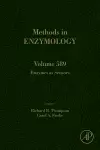
Enzymes as Sensors PDF
Preview Enzymes as Sensors
METHODS IN ENZYMOLOGY Editors-in-Chief ANNA MARIE PYLE Departments of Molecular, Cellular and Developmental Biology and Department of Chemistry Investigator, Howard Hughes Medical Institute Yale University DAVID W. CHRISTIANSON Roy and Diana Vagelos Laboratories Department of Chemistry University of Pennsylvania Philadelphia, PA Founding Editors SIDNEY P. COLOWICK and NATHAN O. KAPLAN AcademicPressisanimprintofElsevier 50HampshireStreet,5thFloor,Cambridge,MA02139,UnitedStates 525BStreet,Suite1800,SanDiego,CA92101–4495,UnitedStates TheBoulevard,LangfordLane,Kidlington,OxfordOX51GB,UnitedKingdom 125LondonWall,London,EC2Y5AS,UnitedKingdom Firstedition2017 Copyright©2017ElsevierInc.Allrightsreserved. Nopartofthispublicationmaybereproducedortransmittedinanyformorbyanymeans, electronicormechanical,includingphotocopying,recording,oranyinformationstorageand retrievalsystem,withoutpermissioninwritingfromthepublisher.Detailsonhowtoseek permission,furtherinformationaboutthePublisher’spermissionspoliciesandour arrangementswithorganizationssuchastheCopyrightClearanceCenterandtheCopyright LicensingAgency,canbefoundatourwebsite:www.elsevier.com/permissions. Thisbookandtheindividualcontributionscontainedinitareprotectedundercopyrightby thePublisher(otherthanasmaybenotedherein). Notices Knowledgeandbestpracticeinthisfieldareconstantlychanging.Asnewresearchand experiencebroadenourunderstanding,changesinresearchmethods,professionalpractices, ormedicaltreatmentmaybecomenecessary. Practitionersandresearchersmustalwaysrelyontheirownexperienceandknowledgein evaluatingandusinganyinformation,methods,compounds,orexperimentsdescribed herein.Inusingsuchinformationormethodstheyshouldbemindfuloftheirownsafetyand thesafetyofothers,includingpartiesforwhomtheyhaveaprofessionalresponsibility. Tothefullestextentofthelaw,neitherthePublishernortheauthors,contributors,oreditors, assumeanyliabilityforanyinjuryand/ordamagetopersonsorpropertyasamatterof productsliability,negligenceorotherwise,orfromanyuseoroperationofanymethods, products,instructions,orideascontainedinthematerialherein. ISBN:978-0-12-805406-2 ISSN:0076-6879 ForinformationonallAcademicPresspublications visitourwebsiteathttps://www.elsevier.com/books-and-journals Publisher:ZoeKruze AcquisitionEditor:ZoeKruze EditorialProjectManager:HeleneKabes ProductionProjectManager:MageshKumarMahalingam CoverDesigner:MatthewLimbert TypesetbySPiGlobal,India DEDICATION Dedicated to Dr. Harold J. Bright, Biochemist, Savant, and Peerless Supporter of Young Scientists v CONTRIBUTORS CaitlinE.Anderson UniversityofWashington,Seattle,WA,UnitedStates SilvanaAndreescu ClarksonUniversity,Clarkson,NY,UnitedStates StijnJ.A.Aper LaboratoryofChemicalBiologyandInstituteforComplexMolecularSystems,Eindhoven UniversityofTechnology,Eindhoven,TheNetherlands RemcoArts LaboratoryofChemicalBiologyandInstituteforComplexMolecularSystems,Eindhoven UniversityofTechnology,Eindhoven,TheNetherlands ErfeiBi UniversityofPennsylvaniaPerelmanSchoolofMedicine,Philadelphia,PA,UnitedStates BruceR.Branchini ConnecticutCollege,NewLondon,CT,UnitedStates ClotildeCapacchione InstituteofFoodScience,CNR,Avellino,Italy AlessandroCapo InstituteofFoodScience,CNR,Avellino,Italy AnthonyE.G.Cass DepartmentofChemistry,ImperialCollegeLondon,London,UnitedKingdom SylviaDaunert MillerSchoolofMedicine,UniversityofMiami,Miami,FL,UnitedStates SabatoD’Auria InstituteofFoodScience,CNR,Avellino,Italy HuaiDeng UniversityofMichigan,AnnArbor,MI,UnitedStates SapnaDeo MillerSchoolofMedicine,UniversityofMiami,Miami,FL,UnitedStates EduardDumitrescu ClarksonUniversity,Clarkson,NY,UnitedStates CarolA.Fierke UniversityofMichigan,AnnArbor,MI,UnitedStates xiii xiv Contributors RudolfGriss E(cid:1)colePolytechniqueF(cid:1)ed(cid:1)eraledeLausanne(EPFL),InstituteofChemicalSciencesand Engineering(ISIC);E(cid:1)colePolytechniqueF(cid:1)ed(cid:1)eraledeLausanne(EPFL),Instituteof Bioengineering;NationalCentreofCompetenceinResearch(NCCR)ChemicalBiology, Lausanne,Switzerland JiantaoGuo UniversityofNebraska–Lincoln,Lincoln,NE,UnitedStates ItaruHamachi GraduateSchoolofEngineering,KyotoUniversity,Katsura,Kyoto;CoreResearchfor EvolutionalScienceandTechnology(CREST),JapanScienceandTechnologyAgency, Kawaguchi,Saitama,Japan KaiJohnsson E(cid:1)colePolytechniqueF(cid:1)ed(cid:1)eraledeLausanne(EPFL),InstituteofChemicalSciencesand Engineering(ISIC);E(cid:1)colePolytechniqueF(cid:1)ed(cid:1)eraledeLausanne(EPFL),Instituteof Bioengineering;NationalCentreofCompetenceinResearch(NCCR)ChemicalBiology, Lausanne,Switzerland TomK.Kerppola UniversityofMichigan,AnnArbor,MI,UnitedStates ShigekiKiyonaka GraduateSchoolofEngineering,KyotoUniversity,Katsura,Kyoto,Japan RebeccaY.Lai UniversityofNebraska-Lincoln,Lincoln,NE,UnitedStates MidEumLee TheOhioStateUniversity,Columbus,OH,UnitedStates AdeliaMajoli InstituteofFoodScience,CNR,Avellino,Italy MaartenMerkx LaboratoryofChemicalBiologyandInstituteforComplexMolecularSystems,Eindhoven UniversityofTechnology,Eindhoven,TheNetherlands RobertH.Newman NorthCarolinaAgriculturalandTechnicalStateUniversity,Greensboro,NC,UnitedStates WeiNiu UniversityofNebraska–Lincoln,Lincoln,NE,UnitedStates SatoshiOkada UniversityofPennsylvaniaPerelmanSchoolofMedicine,Philadelphia,PA,UnitedStates; KyushuUniversityGraduateSchoolofMedicalSciences,Fukuoka,Japan AmyPalmer UniversityofColoradoBoulder,Boulder,CO,UnitedStates Hay-OakPark TheOhioStateUniversity,Columbus,OH,UnitedStates Contributors xv AngelaPennacchio InstituteofFoodScience,CNR,Avellino,Italy LynnSanford UniversityofColoradoBoulder,Boulder,CO,UnitedStates AlbertoSchena LucentixSA,Lausanne,Switzerland KamalG.Shah UniversityofWashington,Seattle,WA,UnitedStates SanjivSharma DepartmentofChemistry,ImperialCollegeLondon,London,UnitedKingdom TaraL.Southworth ConnecticutCollege,NewLondon,CT,UnitedStates MariaStaiano InstituteofFoodScience,CNR,Avellino,Italy RichardB.Thompson UniversityofMarylandSchoolofMedicine,Baltimore,MD,UnitedStates AntonioVarriale InstituteofFoodScience,CNR,Avellino,Italy DanielWynn MillerSchoolofMedicine,UniversityofMiami,Miami,FL,UnitedStates PaulYager UniversityofWashington,Seattle,WA,UnitedStates KeiYamaura GraduateSchoolofEngineering,KyotoUniversity,Katsura,Kyoto,Japan QiuliyangYu E(cid:1)colePolytechniqueF(cid:1)ed(cid:1)eraledeLausanne(EPFL),InstituteofChemicalSciencesand Engineering(ISIC);E(cid:1)colePolytechniqueF(cid:1)ed(cid:1)eraledeLausanne(EPFL),Instituteof Bioengineering;NationalCentreofCompetenceinResearch(NCCR)ChemicalBiology, Lausanne,Switzerland JinZhang UniversityofCalifornia,SanDiego,SanDiego,CA,UnitedStates PREFACE The Editors are proud to present this volume of Methods in Enzymology, focused largely on Enzymes as Sensors. We are fortunate to have gathered aconstellationofstarinvestigatorstodescribetheircurrentworkinthisfield. Theeditors(andmanyoftheauthors)havefeltforsomeyearsthatforsens- ingandmanyothertasks,biomolecules,suchasenzymes,haveoutstanding attributes. Indeed, biomolecules now represent the method of choice for recognition of many analytes and transducing their presence or level as a signalonecaninterpret.Inthiscase,necessityhasbeenthemotherofinven- tionbecauseansweringtheessentiallyanalyticalquestionsinbiologyofhow muchofananalyteispresent,howfastisthatamountchanging,andhowisit distributedinthematrix(oftenofalivingcell),andcollectingthisinforma- tioninrealtimeonasubmicronscaleisachallengebeyondmosttraditional analytical methods. The proportion of the chapters herein describing methodsfocusedonansweringpreciselysuchdifficultquestionsisanindex oftheinherentpowerofenzymesandotherbiologicalmoleculestoaddress such questions. ThevolumebeginswithachapterbyDrs.SanfordandPalmerreviewing oneofthecentraldevelopmentsofrecentyears,theuseofexpressiblefluo- rescentproteinsinsensorsofmanykinds.Thesecondchapter,byDr.Wynn andcolleagues,detailsanoveldevelopmentforincreasingtheruggednessof biologicallyderivedsensors,namely,encodingtheminaveryrobustform, the bacterial spore. The chapter by Dr. Arts et al. covers a rapidly growing sensing approach with exciting new applications called bioluminescence resonanceenergytransfer,orBRET.Dr.Staianoandcolleaguesfollowwith achapteronusingenzymesassensors,whichfocusesonapoenzymesasnon- consumingsensors.Drs.NewmanandZhangtakeamuchbroaderviewin thefifthchapter,usingdiverseapproachestounderstandsignalingnetworks well above the cellular scale. Conversely, Dr. Okada et al. in their chapter zoominonaGTPasecomponentofthesignalingcascadethatcontrolsthe polarityofyeastbudding.Drs.NiuandGuodescribeapowerfulapproach, incorporating a variety of different, unnatural amino acids into protein sensors for diverse sensing applications. The eighth chapter by Dr. Lai is an outstanding review of electrochemically based nucleic acid sensors and their unique advantages. In the next chapter, Dr. Yamaura et al. describe averysubtleapproachforadaptingtherecognitioncapabilitiesofcellsurface xvii xviii Preface receptorssuchastheGABA receptortoturnonsensors.TheEditorsnext A discuss numerous issues in the sensing of metal ions, with zinc as an arche- type. Dr. Dumitrescu and colleagues describe another group of electro- chemically transduced sensors, emphasizing determination of key analytes such as neurotransmitters and reactive oxygen species. Drs. Branchini and Southworth in the twelfth chapter also focus on bioluminescent sensing in describing their engineered luciferases for ATP detection. Dr. Johnsson and his colleagues describe a flexible, modular approach to bioluminescent sensingthatiswellsuitedforpoint-of-careapplications.Inthe14thchapter, Dr.Andersonandhercolleaguesdescribeafascinating approachtosensing inaustereenvironmentsusingpaper-basedsensing.Dr.Cassandcolleagues take us farther afield in describing sensors that incorporate microneedles specifically to gently pierce the skin to provide access to interstitial fluid and its analytes. In the final chapter, Dr. Kerppola and colleagues describe an exciting approach for sensing called bimolecular fluorescence comple- mentation, and its application to studying multiprotein complexes with fly polytene chromosomes. After more than 60 years, Methods in Enzymology as a series, and devel- oping new methods in experimental science in general, is still relevant and worthwhile. Technology development remains a fruitful part of the scientific enterprise, at least as judged by citations: In January, 2017, 13 of the15mostcitedpapersintheProceedingsoftheNationalAcademyofSciences (http://www.pnas.org/reports/most-cited)wereovertlymethodologicalin nature albeit from many fields, and all of the top 10 most cited papers overall are methodological (Van Noorden et al., Nature 514, 550 (2014)). Moreover, the highly cited nature and consequent impact of methodolog- icalpapershasbeenmaintainedinthebiologicalandchemicalsciencesforat least 40 years. In the current “business model” of government/nonprofit fundingofacademicresearch,acasecouldbemadethat(forinstance)Sanger et al.’s invention of dideoxy sequencing (cited 68,000 times and counting) represents a good return on investment. We hope you enjoy this collection. RICHARD B. THOMPSON and CAROL A. FIERKE CHAPTER ONE Recent Advances in Development of Genetically Encoded Fluorescent Sensors Lynn Sanford, Amy Palmer1 UniversityofColoradoBoulder,Boulder,CO,UnitedStates 1Correspondingauthor:e-mailaddress:[email protected] Contents 1. Introduction 2 2. FluorescentProteins 2 2.1 IntrinsicChromophoreFPs 3 2.2 ExtrinsicChromophoreFPs 4 3. SensorPlatforms 11 3.1 FRETSensors 14 3.2 Fluorescence-ModulatedSingleFPSensors 20 3.3 TranslocationSensors 24 3.4 ComplementationSensors 25 3.5 DimerizationSensors 26 4. TypesofSensors 26 4.1 Ions/Metals 27 4.2 pH 28 4.3 Metabolites 29 4.4 Signaling 30 4.5 Redox 32 4.6 ForceandCrowding 32 4.7 Voltage 33 5. Conclusion 34 References 34 Abstract Genetically encoded fluorescent sensors are essential tools in modern biological research,andrecentadvancesinfluorescentproteins(FPs)haveexpandedthescope of sensor design and implementation. In this review we compare different sensor platforms, including Fo€rster resonance energy transfer (FRET) sensors, fluorescence- modulated single FP-based sensors, translocation sensors, complementation sensors, anddimerization-basedsensors.Wediscusselementsofsensordesignandengineering foreachplatform,includingtheincorporationofnewtypesofFPsandsensorscreening MethodsinEnzymology,Volume589 #2017ElsevierInc. 1 ISSN0076-6879 Allrightsreserved. http://dx.doi.org/10.1016/bs.mie.2017.01.019 2 LynnSanfordandAmyPalmer techniques.Finally,wesummarizethewiderangeofsensorsintheliterature,exploring creativenewsensorarchitecturessuitablefordifferentapplications. 1. INTRODUCTION Biological sensors are fundamental to current research, from quanti- fying metabolites under different perturbations to identifying cell states. Manytypesofsensorsexistwithavarietyofreadouts,withoneofthemost widely used platforms being fluorescent sensors. Of these, genetically encoded sensors are advantageous for their versatility, modularity, and tunability. Inthisreviewweoutlinedifferentgeneticallyencodedfluorescentsensor platformsandtheirproteinandpeptidecomponents.Weparticularlyfocus on how engineering approaches vary among different sensor platforms and how new technologies such as novel fluorescent proteins (FPs) have been usedtogenerateandoptimizesensors.Wealsoprovideinterestingexamples oftherangeofsensorsdevelopedoverthelast20years.Forthepurposesof this review, we define “genetically encoded” to mean that sensors require the addition of no exogenous components, such as unnatural amino acids. 2. FLUORESCENT PROTEINS The most important components of genetically encoded fluorescent sensorsareFPs.AlargenumberofFPshavebeendiscoveredanddeveloped overthepasttwodecades,beginningwiththecloning,expression,andopti- mization of green fluorescent protein (GFP) from Aequorea victoria in the 1990s (Tsien, 1998). These proteins fit under two broad categories: those that generate an intrinsic chromophore during folding and maturation, andthosethatbindanexogenouschemicalchromophorefromthecellular environment.ThefirstcategoryincludesbyfarthemostwidelyusedFPsin sensors, although in the past decade innovations in extrinsic chromophore FPs have led to their increased utility, especially in circumstances where oxygen requirements or chromophore maturation kinetics do not favor intrinsic chromophore FPs. FPs are available in colors spanning the visible range of the spectrum, andeachhasanumberofpropertiesthatarerelevanttotheiruseinsensors and in cells. Factors such as quantum yield (φ), extinction coefficient (ε),
